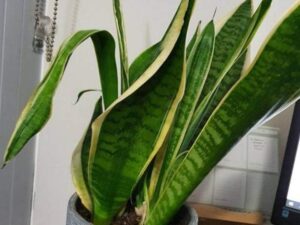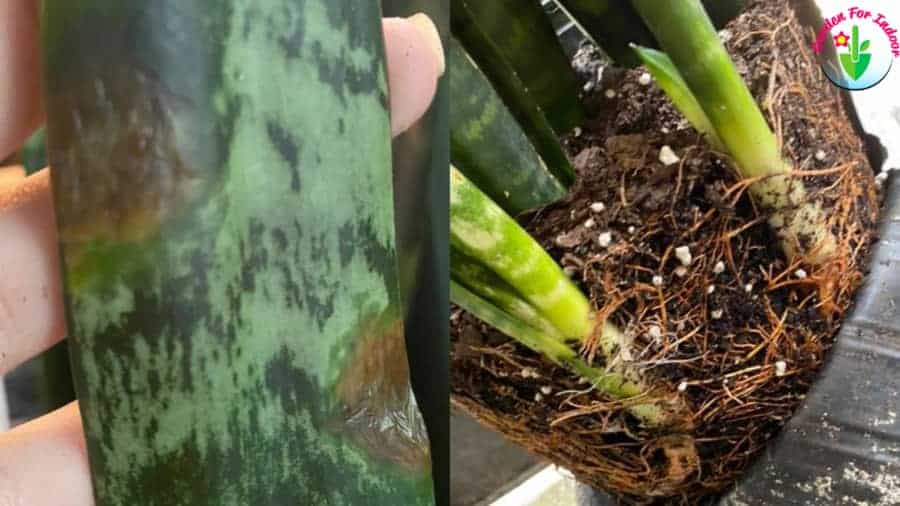Snake plants are popular houseplants because they need the minimum amount of care to thrive. But they have some common problems every once in a while. If you notice your snake plant leaves are curling then it’s time for you to get into action.
But here’s the catch, If you don’t know what is causing the curling of leaves you will not be able to treat your snake plants properly. You might even end up taking the wrong measure and hurting your precious snake plants.
So, why are the snake plant leaves curling?
Wrong watering, lack of sunlight, temperature variation, too much fertilizer, root rot, insect attack, transplant shock, wrong soil, and incorrect pot size are the 9 reasons that cause curling in snake plants.
The cool thing is, this article has got you all covered. Continue reading to understand what is causing the leaves to curl on your snake plant and how to battle them.
So, without any delay let’s get going-
Why Are The Snake Plants Curling?

1. Wrong Watering Of Snake Plants
Both underwatering and overwatering can cause curling in snake plants. We know that snake plants are drought-resistant. But they still have a limit. If the snake plants are under-watered over a long time they will curl inward to preserve the moisture.
On the other hand, overwatering also does the same thing. overwatering is more dangerous. Because continuously overwatering can kill your snake plants. Too much water makes the leaves soft and they start curling downwards. In addition, the plant looks like it’s drooping.
Control Measure
Snake plants don’t need much watering. So water them every 2-3 weeks. Even if they are underwatered, do not go overboard with watering.
Now the question is how much to water them? Well, it’s difficult to tell how much to water. Because there is no fixed amount in terms of watering. It greatly varies with season, environmental condition, type of plant, pot size, etc. So, It’s better to test the soil with a moisture meter to know exactly how much to water (our pick: Atree Soil 3-in-1 Soil Tester Kits)
2. Lack of Sunlight

Snake plants don’t need much sunlight. However, they do require a minimum amount of sunlight to stay healthy. When they don’t get enough light their rate of photosynthesis reduces. As a result, the leaves start curling and turning yellow.
Control Measure
To fix the curling of leaves you need to move your snake plant to a sunny place. If you have it as a houseplant, move it near an east-facing window so that the plant will get maximum exposure to the morning sun. But if the weather is gloomy in your area then you can put them under artificial grow lights (our pick: LEOTER Grow Light for Indoor Plants) But always remember one thing, if the sun exposure is more than 7 hours a day during very hot weather conditions then your snake plant will still curl and turn brown.
3. Temperature Variations
Snake plants prefer to be in the temperature between 55-85°F (12-30°C). During very high temperatures they start to lose a lot of water. As a result, the leaves start to curl.
But in very low temperatures the water on the leaves freezes and forms crystals. These crystals permanently damage the leaves.
Control Measure
If you live where the temperature is always higher than 85°F then you must provide your snake plant some afternoon shade. If you have potted snake plants, bring them indoors during very hot spells.
On the other hand, make sure your snake plants are indoors during the winter season. You can also cover your plant with blankets or sheets to keep it warm in the winter.
4. Too Much Fertilizer

One reason for your snake plant curling can be too much use of fertilizer. You see, they don’t require a lot of fertilizer. So, when you go overboard with it their roots get damaged and the leaves start to curl inwards.
Control Measure
To avoid over-fertilizing, try applying a good slow-releasing nitrogen-rich fertilizer every two months (our pick: Aquatic Arts All-purpose House Plant Fertilizer). You can also avoid over-fertilizing by using organic fertilizers.
Always follow the instructions on the package and maintain the recommended dose so that you don’t end up causing fertilizer burn to your snake plants.
5. Root Rot Of Snake Plant

When the snake plants are in waterlogged condition fungal problems like root rot occur. The roots get injured due to excess water. So, the leaves don’t get enough water and nutrients from the injured roots. As a result, the snake plant leaves curl inwards and turn yellow.
Take out your snake plant from the soil and wash the roots with running water. If there’s a foul smell coming out from the roots, it indicates root rot.
Control Measure
Treating root rot at the right time is very crucial because it can be fatal to your snake plants. Apply the best fungicide to your snake plant that will effectively kill the fungi responsible for root rot (our pick: Garden Safe Brand Fungicide).
Try these amazing homemade recipes given below to control the fungal problems more naturally.
#Recipe 1:- Homemade Leaf Curl Spray
Ingredients:
- 2 liter of water
- 30 ml of copper sulfate
- 5 tablespoons of hydrated lime (Calcium hydroxide)
Steps:
- Combine water and hydrated lime in a plastic bucket
- Do not use any metal bucket. Because the ingredients react with metal
- Stir the mixture slowly with a plastic spoon. Avoid any metal spoon
- Now, Start adding the copper sulfate into the container
- Continue to stir
- You have to keep stirring because the hydrated lime will settle down very quickly
- Pour the mixture into the sprayer
- Shake the mixture very well before starting to spray
- Spray on the curled leaves of your snake plant
- Wash the sprayer thoroughly after spraying because this mixture is very corrosive
- Don’t store this mixture for future use
- Prepare a new solution every time
Recipe 2:-Baking Soda Spray Recipe
Ingredients:
- 3 teaspoons of baking soda
- 1 teaspoon of liquid dish soap
- 1 teaspoon of any cooking oil
- 3 liter of water
Steps:
- Combine baking soda and cooking oil to a mixing bowl
- Then add the liquid dish soap
- Mix with water and stir slowly
- Pour it into the sprayer
- Spray on your snake plants twice a week
Note: Before spraying these homemade insecticides to your snake plant try on a small leaf first. If the leaf shows any abnormality then dilute the solution and try again in a small leaf. If it still doesn’t work then skip using that particular recipe for your snake plants.
6. Insects On Snake Plants
Mealybugs, spider mites, and thrips attack the snake plants a lot. All these insects are very tiny and very difficult to spot. You can only spot them by using a magnifying glass. But their attack leaves some symptoms that help us detect their presence.
They suck the juice out of the leaf and make rough, uneven patches on them. Moreover, they make the leaves yellow, curled, and wrinkled.
Control Measure
Get rid of these pesky pests before they transmit other viral diseases to your snake plant. Get the best insecticide for them that’s equally effective against the insects and safe for the environment (our pick: Bonide (BND951) – Systemic House Plant Insect Control).
You can also mist the plant leaves and wipe the water with a cloth. It will remove some insects from the leaves but this will not be effective when the infestation is large.
Cut the soggy and smelly part of the roots. Disinfect the rest of the roots with a dilute hydrogen peroxide solution. Then plant them in new potting soil.
Apply insecticidal soap or neem oil to your snake plants for organic control. The recipes are given below
#Recipe1:-Insecticidal Soap Recipe
Ingredients:
- 250 ml of any cooking oil
- 3 teaspoons of liquid dish soap
Steps:
- Add the oil and liquid dish soap together and mix
- Store this mixture in a bottle
- Add 3 teaspoons of this mixture to a liter of water
- Spray directly into both sides of the leaves surface of your snake plant
#Recipe 2:- Neem Oil Recipe
Steps-
- Mix 1 tablespoon of neem oil in a liter of water
- Pour the solution into the sprayer
- Spray it twice a week on your snake plants
- You can also spray it regularly as a preventive measure
7. Transplant Shock
Transplanting can be a reason why your snake plants are curling. You see, when you uproot and plant the snake plants in another place they take some time to adjust to the new environment. The roots take some time to adapt to new soil.
So, it fails to provide the plant with enough water and nutrients. As a result, the plant leaf starts to curl.
Control Measure
Transplanting shock is very common with the plants and you have to follow just the normal caring routine.
After transplanting keep them in partial shade and keep watering as much as they need, provide them enough sunlight, and make sure the soil is good and fertile. Your snake plants will revive themselves on their own.
8. Incorrect Soil
Snake plants prefer soil with a pH range of 5.5 to 7.5. So your snake plants can be curling because the soil pH is not within their preferred range. Moreover, the leaves turn brown because of the wrong soil pH.
Also, when the soil is too compact the water won’t drain quickly. As a result, your plant leaves will be curling due to root rot.
Control Measure
It’s better to check the soil with a pH meter before going to action. If the pH is low add hydrated lime to increase the soil pH. If the pH is high add some lemon juice with the irrigation water.
You can also add acidic or alkaline fertilizer to amend the soil depending on your soil pH condition. If the soil is too compact, loosen the soil or add some sand to improve the drainage.
9. Wrong Pot Size
Snake plants need larger pots to grow their roots as healthy plants. If your pot is smaller than the plant size then the roots won’t have enough space to grow properly. And your plant will be curling and drooping.
Control Measure
As the plant starts to grow, keep changing the pot according to their sizes so that the roots can breathe well within the pots.
Also, make sure the pot has enough drainage holes to facilitate good drainage. Because the snake plants don’t like water stagnant conditions at all.
Conclusion
Snake plants are very tolerant and resilient against unsuitable conditions. Rarely though, they do face some problems and curling is one of them. With your little amount of help, they can go back to being healthy again and continue to spread happiness.
I have tried to include all the possible causes and their solutions in this article. I hope you found all the information helpful and easy to follow. If you have any further questions drop a comment below.
